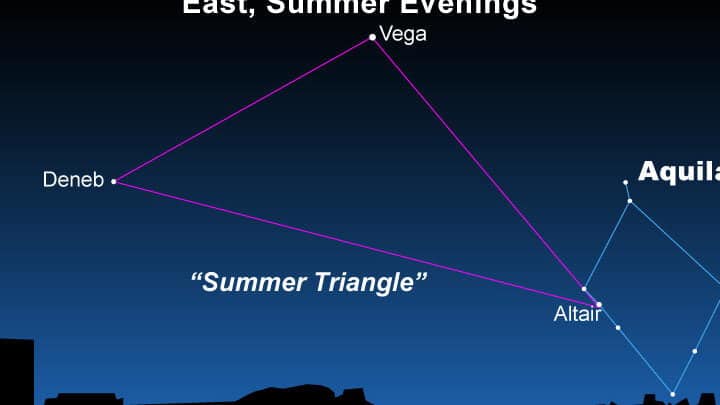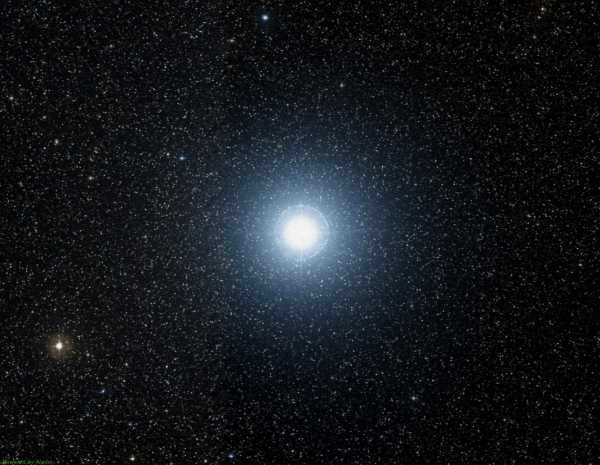
Thanks to the advancements in telescope technology, astronomers have recently been able to observe and measure the rotation of a star at an unprecedented level of detail. By utilizing the Palomar Interferometer, a collection of telescopes working in tandem, scientists were able to determine the star’s radius based on its position in the sky. Surprisingly, they discovered that the star’s radius varied depending on its angle of rotation, indicating that it possesses an irregular shape.
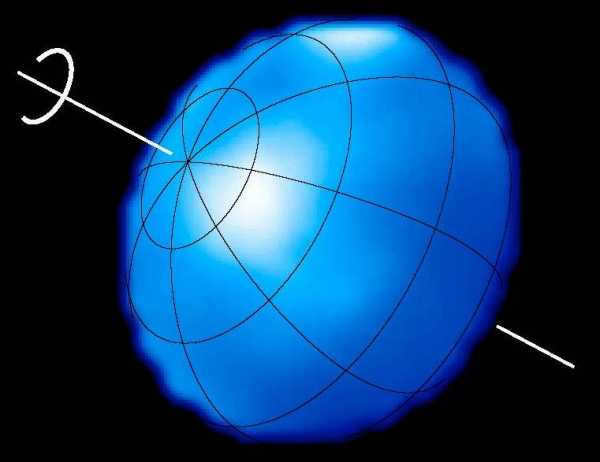
Altair, a star that is a part of the A7IV-V spectral class, is known for its hot and white characteristics. It can be found in one of the vertices of the “summer-fall triangle” and is visible in the Northern Hemisphere during the fall and summer seasons. Interestingly, it wasn’t until 2007 that an actual image of Altair was captured.
Distance and location
The separation between our planet and Altair is 16.8 light-years, equivalent to 5.14 parsecs, making it one of the nearest stars to Earth. In terms of kilometers, this vast expanse amounts to a staggering 159 trillion. Alongside Gamma Eagle and Beta Eagle, it forms a notable constellation of stars, often referred to as the Eagle Shaft or the Eagle Family.
This celestial body is classified as type A on the main sequence in terms of its spectrum. It has a mass approximately 1.8 times larger than that of the Sun and a luminosity 11 times greater.
Topic-based materials
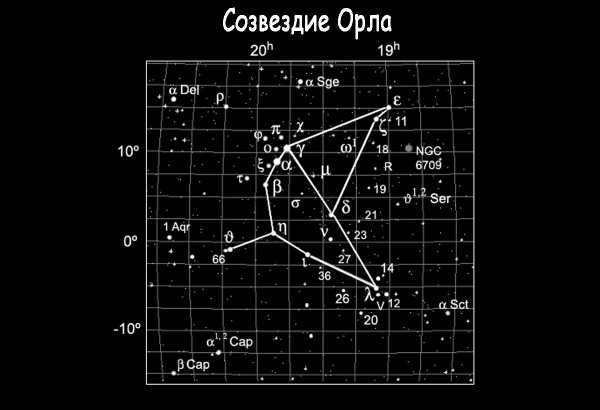
The star Altair belongs to the constellation of Eagle.
Altair rotates around its axis very quickly, completing one rotation in just 8.9 hours. Its speed is 286 km/s. In comparison, the Sun takes 25.05 days to complete a full circle with an equatorial speed of 2 km/s. During its rotation, Altair’s diameter is 22% larger in the equatorial region than in the pole region.
In 1999, the Wide Field Infrared Explore conducted satellite measurements which revealed that the luminosity of this nearby star varies minimally, by less than 0.001 magnitudes. Observations in 2005 classified the star as a Beta Shield variable. In the 1960s, Robert Brown and his team used interferometry to measure the star’s angular diameter, which was found to be 3 angular milliseconds. At that time, there was a hypothesis that Altair would be heavily compressed due to its rapid rotation, but the lack of precise visibility prevented its confirmation.
Learning
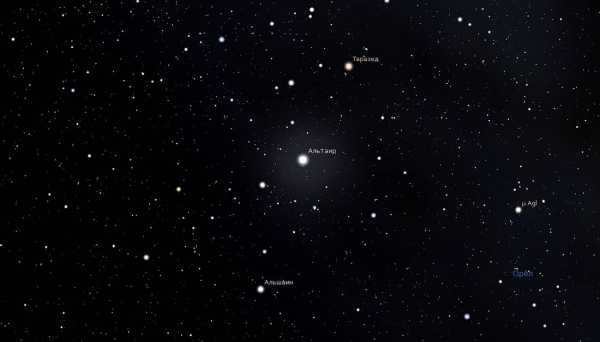
Screenshot taken from the planetarium software
In 1999 and 2000, Gerard van Belle and his colleagues conducted a study and put forward a hypothesis that Altair, due to its fast rotation, experiences gravitational darkening on its surface and has a lower temperature at the equator than expected. The star’s equator appears less bright, a phenomenon known as gravitational darkening. In 2005, Dominicano de Souza used the VINCI instruments at VLT to measure gravitational darkening. Altair is among the few stars for which images of their disks have been obtained. Similarly, one can observe, without difficulty, the effect of surface compression and gravitational darkening on Altair.
Comparison between models of the star’s surface and actual images
To observe the surface of this object in great detail, a telescope with a mirror diameter of 300 meters is required. However, achieving this parameter is currently unattainable. Despite this limitation, astronomers have managed to view and study the star using multiple telescopes.
[1] (α Aql / Alpha Eagle) is the most brilliant star in the Eagle constellation and the 12th brightest star in the night sky. It has a visible luminosity of 0.77m. The name originates from the Arabic term “
an-nasr at-tair
“, which translates to “soaring eagle” in English.
Altair is one of the prominent stars in the “summer-fall triangle” visible in the Northern Hemisphere during the summer and autumn months. It, along with Beta and Gamma of Eagle, forms a well-known line of stars often referred to as the Eagle family.
The surface of Altair was imaged for the first time in 2007 using the CHARA interferometer[2].
| Altair | |
| Star | |
| An image of the star obtained by the Palomar Observatory interferometer | |
| Observational data (J2000 era) | |
| Right ascension | 19h 50m 47s |
| Declination | +08° 52′ 06″ |
| Distance | 17 light years (5.15 parsecs) |
| Visible stellar magnitude (V) | 0.77m |
| Constellation | Eagle |
| Astrometry | |
| Radial velocity (Rv) | -26.1 km/s |
| Proper motion (μ) | RA: 536.82 milliarcseconds per year Dec: 385.54 milliarcseconds per year |
| Parallax (π) | 194.97 ± 0.86 milliarcseconds |
| Absolute stellar magnitude (V) | 2.22 |
| Characteristics | |
| Spectral class | A7 V |
| Color index (B – V) | 0.22 |
| Color index (U – B) | 0.08 |
| Variability | δ Shield type |
| Physical characteristics | |
| Mass | 1.7 solar masses |
| Radius | 1.7 solar radii |
| Age | |
| Temperature | 8000 K |
| Luminosity | 10.7 solar luminosities |
| Metallicity | 200% of solar |
| Rotation | 6.5-10.4 hours |
| Wikidata information ? | |

Stars belonging to various spectral classes
Altair is situated at a distance of merely 16.8 light-years (equivalent to 5.14 parsecs or 159 trillion kilometers) from our planet. It stands out as one of the nearest stars that can be observed without any optical aids and takes the position of the closest star of spectral class A, right after Sirius.
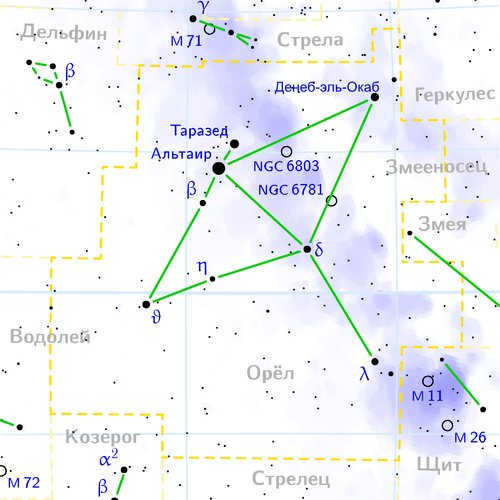
The constellation Aquila
Altair is a white-hot star belonging to the spectral class A7 V of the main sequence. It has a mass of approximately 1.8 solar masses and a luminosity of 11 solar luminosities. Altair rotates at a high speed, completing one full revolution on its axis in just 8.9 hours, with an equatorial velocity of 286 km/s. In comparison, the Sun takes 25.05 days to complete a full revolution at an equatorial speed of 2 km/s. Due to its rapid rotation, Altair’s diameter at the equator is 22% larger than at the poles.
In 1999, the Wide Field Infrared Explorer conducted satellite measurements that revealed slight variations in Altair’s brightness, with a range of less than one thousandth of a star magnitude. Subsequently, in 2005, Altair was identified as a δ Shield type variable. The fluctuations in its light can be represented by the addition of multiple sine waves, each with periods ranging from 0.8 to 1.5 hours.
Parameters of the Star[edit right code]
Stars belonging to different spectral classes
Altair is located just 16.8 light-years away (equivalent to 5.14 parsecs or 159 trillion kilometers) from Earth. It is one of the closest stars that can be seen with the naked eye, and it is the nearest star of spectral class A after Sirius.
Altair is a white, hot star classified as A7 V on the main sequence, with a mass of approximately 1.8 solar masses. It has a luminosity of 11 times that of the Sun. Altair rotates at a high speed, completing a full revolution on its axis in just 8.9 hours, with an equatorial velocity of 286 km/s. For comparison: the Sun completes a full revolution in 25.05 days, with an equatorial speed of 2 km/s. Due to Altair’s rapid rotation, its diameter at the equator is 22% larger than at the poles.
Compression and surface temperature
The angular size of Altair was determined using interferometric measurements conducted by Robert Brown and his team in the 1960s. Their findings revealed that Altair has a diameter of 3 angular milliseconds[3]. Additionally, they postulated that Altair possesses a significant degree of flattening resulting from its rapid rotation. However, their equipment at the time was not sensitive enough to confirm this hypothesis.
In 1999 and 2000, Gerard van Belle and his colleagues studied Altair using an infrared interferometer at the Palomar Test Center[4]. According to the theory, Altair’s rapid rotation causes its surface gravity, effective temperature, and brightness to decrease from the poles to the equator. This phenomenon, known as gravitational darkening, was confirmed for Altair in 2001 using measurements made on an optical interferometer prototype. Oishi (2004) and Peterson et al. (2006) further analyzed this phenomenon[5][6]. Additionally, Dominicano de Souza (2005) investigated gravitational darkening using measurements from the VINCI instrument at VLTI[7]. Altair is one of the few stars for which direct images of its disks have been obtained[8]. The gravitational darkening effect and the flattening effect could be observed directly[9].
About our company
JSC Altair-NTPC was established in 2001 by experts from one of the oldest companies in Russia, the Marine Research Institute of Radio Electronics “Altair”.
Since its inception, JSC Altair-NTPC has been collaborating with OJSC “Head System Design Bureau of Air Defense Concern “Almaz-Antey” named after academician A.A. Raspletyn” to develop ARM-OI devices – the operator’s air defense system used by the Navy and supplied by GSCB.
The primary focus of the research and production enterprise JSC “Altair – NTPC” is to design global situational awareness systems for the Ministry of Defense of the Russian Federation and the Navy, as well as to develop console equipment for automated workstations (AWS) in coastal and ship-based systems and complexes. Additionally, the enterprise is involved in the construction of control and information processing systems based on AWS devices.
Since 2004, the enterprise has played a key role in developing regional subsystems of the Unified State System of Surface and Underwater Situational Illumination (USSONPO). The creation of this system, which was mandated by the decree of the President of the Russian Federation, aims to ensure the safety of Russian maritime activities.
Currently, JSC Altair-NTPC is delivering ARM-OI devices and Kuzen ARM-UE for various naval systems such as air defense systems, air defense systems, and RER. The company is also actively working on developing new versions of ARM devices that incorporate modern components, production techniques, and information technologies. These advancements are made to meet the ever-increasing demands for reliability, ergonomics, and performance of the equipment.
One of the key areas of focus for the company in console equipment development is the creation of a portable and compact console known as the Small-Size Mobile Console (SMMP). This console is designed to have both wireless and wired connectivity options, low power consumption, and high-quality information display.
JSC Altair – NTPC is one of the organizations involved in the implementation of the approved concept by the Russian Government to establish a lighting system in the Arctic.
This company is dedicated to the development of innovative technologies for hydroacoustic and radar monitoring of the marine environment, which greatly enhances the search, detection, and tracking capabilities of objects from ships, aircraft, and even space vehicles.
JSC “Altair – NTPTs” has been tasked by the Ministry of Industry and Trade of Russia to develop an ultra-wideband multifunctional radar system (UWMRS) and is also actively involved in the development of technology for an over-the-horizon radar that utilizes the waveguide propagation of radio waves (known as the “Ozon” radar).
Within a radius of 10 light-years from Altair, the following star systems can be found:
| Star | Spectral class | Distance, light-years |
| Wolf 1055 AB | M3.5 Ve / M8 Ve | 3.7 |
| 70 Serpentine AB | K0 Ve / K5 Ve | 7.8 |
| HIP 103039 | M4 V | 9.1 |
| 61 Swan AB | K5 Ve / K7 Ve | 9.8 |
| V1581 Swan AB | M5.5 Ve / M6V | 9.8 |
| AC+17 534-10 | M3.5 Ve | 10.0 |
Definition of the name Altair

The star Altair feels both distant and near, resembling a celestial body. Its name originates from the Arabic words Al- and “tair,” symbolizing a harmonious fusion and a shared abode. This name possesses the remarkable ability to unite contrasting qualities and merge incompatible aspects. In essence, it is a benevolent name, bridging the gap between the spiritual and the material, drawing energy from the heavens and radiating luminosity.
This combination is truly captivating. Upon dissecting the Arabic translation, Altair signifies “soaring eagle.” Altair serves as a guardian angel, descending to earth to safeguard those under their protection.
Notes
- Astronomical calendar that is permanent. It is the 7th edition and has been revised. It was edited by V. V. K. Abalakin. – Moscow: Nauka, 1981
- An image of Altair’s surface has been successfully obtained
- The stellar interferometer at Narrabri Observatory-II was used to measure the angular diameters of 15 stars. The authors of the study are R. Hanbury Brown, J. Davis, L. R. Allen, and J. M. Rome. This study was published in the Monthly Notices of the Royal Astronomical Society, volume 137 (1967), pages 393—417, with the Bibcode: 1967MNRAS.137..393H.
- Gerard T. van Belle, David R. Ciardi, Robert R. Thompson, Rachel L. Akeson, and Elizabeth A. Lada conducted a study on Altair’s Oblateness and Rotation Velocity using Long-Baseline Interferometry. Their findings were published in the Astrophysical Journal, volume 559 (October 1, 2001), pages 1155—1164, with the DOI:10.1086/322340, and the Bibcode: 2001ApJ…559.1155V
- Altair’s Asymmetric Surface Brightness Distribution Observed with the Navy Prototype Optical Interferometer, Naoko Ohishi, Tyler E. Nordgren, and Donald J. Hutter, The Astrophysical Journal612, #1 (September 1, 2004), pp. 463-471, DOI:10.1086/422422, Bibcode: 2004ApJ..612..463O.
- Interferometry Reveals Gravitational-darkening Effect on Altair, A. Domiciano de Souza, P. Kervella, S. Jankov, F. Vakili, N. Ohishi, T. E. Nordgren, and L. Abe, Astronomy and Astrophysics442, #2 (November 2005), pp. 567-578, DOI:10.1051/0004-6361:20042476, Bibcode: 2005A&A..442..567D.
- Curiosity Sparked: Observing the Man in the Star, Press Release 07-062, National Science Foundation, May 31, 2007. Accessed online November 25, 2008.
- Imaging the Surface of Altair, J. Monnier et al.
,
Science317
, #5836 (July 20, 2007), pp. 342-345, DOI:10.1126/science.1143205, Bibcode: 2007Sci…317..342M, Accessed on line November 25, 2008. See second column of Table 1 for stellar parameters. - Altair’s surface was captured in images by J. Monnier and his team, as described in their publication “Imaging the Surface of Altair” in the scientific journal Science (Volume 317, #5836, July 20, 2007). The images were obtained using interferometry techniques, which allowed them to measure the angular size of Altair and study its surface.
- The study also mentioned that Altair’s diameter was found to be 3 angular milliseconds by Robert Brown and his colleagues in the 1960s. They speculated that Altair might be highly flattened due to its high rotational velocity, but their equipment at the time was not sensitive enough to confirm this hypothesis.
- For more detailed information about Altair’s stellar parameters, please refer to the second column of Table 1 in the publication.
Compression and surface temperature[edit correct code]
Altair’s angular size was measured interferometrically by Robert Brown and colleagues in the 1960s. They discovered that Altair’s diameter was 3 angular milliseconds[3]. They also proposed that Altair could be highly flattened due to its rapid rotation, but they lacked the necessary equipment to observe this phenomenon accurately.
In 1999 and 2000, Gerard van Belle and his co-authors conducted a study on Altair using an infrared interferometer at the Palomar Test Center[4]. The study aimed to examine the effects of Altair’s rapid rotation on its surface gravity, effective temperature, and brightness. According to theory, these properties should decrease from the poles to the equator, a phenomenon known as gravitational darkening. Measurements taken on a prototype optical interferometer in 2001 confirmed this gravitational darkening effect on Altair and were further analyzed by Oishi (2004) and Peterson et al. (2006)[5][6]. Dominicano de Souza (2005) also investigated gravitational darkening using measurements obtained with the VINCI instrument at VLTI[7]. Altair stands out as one of the few stars for which direct images of its disks have been captured[8]. This allowed for the direct observation of the gravitational darkening effect, as well as the flattening effect[9].
Name Altair, Meaning of the male’s name Altair, Origin of the name Altair
The significance of the name Altair:
Altair, a name for boys, means “aviator”. It has an impact on Altair’s character and destiny.
Origin of the name Altair:
A shortened version of the name:
Also, read: Eridanus Constellation Constellation ContentsMain stars of the constellation EridanusInteresting objects to observeFinding the constellation in the skyHistory of the constellation EridanusEridanus is a constellation of the southern hemisphere, ranking sixth in the list.
What Altair means:
The star Altair (Eagle) is named after the brightest star in the Eagle constellation and the 12th brightest star in the sky, with an apparent magnitude of 0.77. Its name, “an-nasr at-tair” in Arabic, translates to “flying eagle”. Altair is a hot, white star of spectral class A7IV-V and is located only 16.8 light-years away from Earth, making it one of the closest stars visible to the naked eye.
Altair is not celebrated as a church holiday.
- Zodiac – Aquarius, Capricorn.
- Element – Air.
- Colors – Blue-black, Tomato.
- Metal – Iron
- Tree – Ash.
- Planet – Saturn
- Constellation – Wolf.
- Number – Five
- Food – Meat
- Animals – Saiga
- Stones – Pearls
Alpha Aquilae, also known as Altair, is the dominant star in the constellation Aquila and the twelfth most brilliant star in the night sky. This celestial body is currently positioned in the G-cloud, which is the closest interstellar cloud consisting of gas and dust. Altair is classified as a main-sequence A star and has an apparent visual magnitude of 0.77. It is one of the key points of the Summer Triangle asterism, along with Deneb and Vega. Altair is located approximately 16.7 light-years (5.13 parsecs) away from our Sun and stands out as one of the nearest stars that can be observed without the use of a telescope.
Altair is rotating rapidly, reaching a speed of approximately 286 km/s at its equator. This is a substantial portion of the star’s projected collapse velocity, which is estimated to be 400 km/s. A study conducted with the Palomar Testbed interferometer has revealed that Altair is not perfectly spherical; instead, it is flattened at the poles due to its high rotational speed. This phenomenon has been further confirmed through various interferometric studies conducted using multiple infrared telescopes.
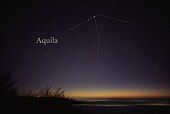
Altair, the brightest star in the constellation Aquila, holds the distinguished title of α Aquilae according to Bayer’s nomenclature. Its traditional name, Altair, has been in use since medieval times and is derived from the Arabic phrase النسر الطائر (An-nisr) Al-ta’ir, meaning “flying eagle”.
In 2016, the International Astronomical Union formed the Working Group on Star Names (WGSN) with the aim of cataloging and standardizing proper names for stars. The first WGSN bulletin published in July 2016 featured a table of the initial two batches of approved names, which included Altair for this particular star. As a result, Altair is now officially listed in the IAU Star Names Catalog.
Physical attributes
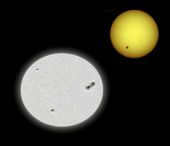
Altair is part of the Aquila constellation and is often associated with two other stars, β Aquilae and γ Aquilae, forming the Aquila Family or the Aquila Tree.
Altair is a main-sequence star of type -A and is approximately 1.8 times the mass of the Sun and 11 times as luminous. It has a fast rotation, completing a full revolution in about 9 hours, compared to the Sun’s 25 days. Due to its rapid rotation, Altair is slightly flattened, with its equatorial diameter being more than 20 percent larger than its polar diameter.
Effects of rotation
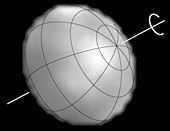
An actual picture of Altair was obtained using the CHARA array.
In the 1960s, R. Hanbury Brown and his team at the Narrabri Observatory used interferometry to measure the angular diameter of Altair. They determined that it had a diameter of 3 milliseconds. While they were aware that Altair would be flattened due to its rotation, they did not have enough data to observe this experimentally. It was later discovered in 1999 and 2000 through infrared interferometric measurements taken by the Palomar Testbed interferometer that Altair is indeed flattened. G. T. van Belle, David R. Ciardi, and their colleagues published this finding in 2001.
According to the theory, Altair’s rapid rotation leads to lower surface gravity and effective temperature at its equator, resulting in less brightness compared to the poles. This phenomenon, known as gravitational darkening or the von Seipel effect, was proven for Altair in 2001 through measurements conducted by the Navy’s prototype optical interferometer. The analysis of these measurements was carried out by Ohishi et al. (2004) and Peterson et al. (2006). Additionally, A. Domiciano de Souza et al. (2005) confirmed the occurrence of gravitational darkening using measurements obtained from the Palomar and Navy interferometers, as well as new measurements obtained from the VINCI instrument at VLTI.
Origin, folklore, and societal influence
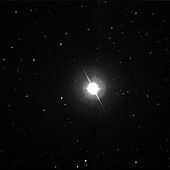
Altair
The Al-Ahsasi catalog al Mouakket introduced the term al-Nesr al-Tair, which was translated into Latin as Vultur Volans. The Arabs referred to the constellation Altair, β Aquilae, and γ Aquilae with this name, which likely originated with the ancient Babylonians and Sumerians who called Altair the “eagle-star”. The spelling Atair was also utilized. Medieval astrolabes from England and Western Europe featured Altair and Vega depicted as birds.
The Coory people in Victoria also identified Altair as Bunjil, the wedge-tailed eagle, and β and γ Aquila as his two spouses, the black swans. The Murray River people recognized the star as Totergil. The formation of the Murray River dates back to when the hunter Totergil impaled Otjut, the colossal Murray cod, which, upon being injured, created a waterway through southern Australia before ascending to the heavens as the Dolphin constellation.
The people of Micronesia referred to Altair as Mai-lapa, which translates to “big/big old breadfruit”, while the Maori people named this star Poutu-te-rangi, which means “celestial pillar”.
In Western astrology, Altair was considered a negative omen, signifying potential danger from reptiles.
Among Bugis sailors, Altair is recognized as one of the navigational asterisms, known as bintoéng timoro, meaning “eastern star”.
Altair Airlines, which operated from Philadelphia between 1966 and 1982, was a regional airline.
On December 13, 2007, NASA announced Altair as the name of the Lunar Surface Access Module (LSAM). Additionally, the Be-200 Altair seaplane, which is manufactured in Russia, is also named after a star.
The Altair 8800 was one of the earliest microcomputers designed for home use.
The Suezmax oil tanker, weighing 136,000 tons, owned by Chevron, was originally called Condoleezza Rice (1993), but it was later renamed Altair Voyager (2001).
One of the tankers that was attacked and damaged during the incident in the Gulf of Oman in June 2019 had this name.
Altair Voyager is also the title of a poem written by Carl Wilson Baker in 1919.
These three things are connected – the oil tanker, the poem, and the person. She is the most beautiful among the three, and she brings joy to my heart like the wonderful weather of the heavens!
Observing Satellites in the Sky
The primary star, known as WDS 19508 + 0852A, is accompanied by three dim stars, namely WDS 19508 + 0852B, C, and D. While component B may appear to be in close proximity to A, it is important to note that they are not physically connected.
| B | A | 19 50 40,5 | + 08 ° 52 ′ 13 ″ | 2007 | 192,1 ″ | 287 ° | 9,82 | SIMBAD |
| C | A | 19 51 00,8 | + 08 ° 50 ′ 58 ″ | 2007 | 189,6 ″ | 107 ° | 10,3 | SIMBAD |
| D | A | 2007 | 31,7 ″ | 97° | 11,9 |
References
External links
| Wikimedia Commons has media files related to Altair . |
- The observation of Altair by astronomers, JPL press release, July 25, 2001.
- Directly capturing an image of Altair’s surface, University of Michigan press release detailing the use of the CHARA array in 2007.
- PIA04204: Altair, NASA. Image of Altair from the Palomar Testbed interferometer.
- Altair on the Solar Station.
- Exploring the mysteries of a star similar to the sun, BBC News, June 1, 2007.
- The first images of Altair’s surface features, astromart.com.
- Image of Altair from Aladin.
Coordinates: 19 50 46.9990, + 08° 52 ′ 05.959″.
Derived from the Arabic an-nasr at-ta’ir, meaning “flying eagle”, the star Altair also goes by the name Atair. Altair, Atair. Altair is situated in the constellation of the Eagle and has been recognized since ancient times. It has been given other names such as Ethos and Eagle Star.
Altair holds the position of alpha within the Eagle, located at 1°47′ Aquarius.
As a first magnitude fixed star, Altair is the brightest star in the Eagle constellation and the 12th brightest star in the entire sky. It appears as a pale yellow star situated on the neck of the Eagle. Its translation is “eagle”, and according to Balinger, it can also be interpreted as “wounded”. This star is sometimes referred to as the “Bird of Jupiter”.

The core of the Eagle. Provides the elevation of intellectual thinking, bravery, and professional success. It transforms an individual into a fearless warrior. Altair is also connected to prophecies, futuristic thinking, occult practices, and magic. It often manifests in individuals with a broad perspective on life. It brings unexpected and peculiar occurrences, as well as opportunities for travel. However, when positioned on the cusp of the Eighth House, it signifies death in the air.
Influence: Uranus, Mars; Sun, Mars, Uranus (P.P.Globa).
Altair: a concept
Altair is a symbol of bravery and energy, but it also represents human connections and compassion.
The chart of Leonardo da Vinci showcased the audacity of Altair, as it rose while Saturn reached its highest point. This combination revealed da Vinci’s eagerness to explore new frontiers and expand his horizons, a desire that remained with him throughout his life.
John Lennon had the Sun associated with Altair, as it rose while the Sun reached its highest point on the day he was born. This powerful connection to Altair inspired Lennon’s music, which often served as a protest for peace and human rights.
The life of Jules Verne is another example of Altair’s influence. On the day he was born, the moon was setting as Altair reached its highest point. This connection between Altair and his Moon influenced Verne’s passions and beliefs.
Jules Verne’s novels exemplify the daring and fearlessness of the eagle, which in his case is linked to the less action-oriented Moon.
Altair and mythology
The ancient Greeks regarded the Eagle constellation as one of the primary embodiments of Zeus, the powerful leader of the Greek pantheon. The Eagle has always been associated with fire and lightning. The influence of this constellation gave rise to the most courageous and decisive warriors, blessed with lightning-fast reactions and extraordinary intelligence, symbolized by their ability to soar to great heights and achieve glory. The main celestial bodies associated with this star in our solar system are Mars and Jupiter. Some opinions also include Uranus.
The significance of the Eagle has traditionally been embraced by powerful nations with ambitious military goals. This symbolism has been utilized by civilizations such as the Roman Empire, Nazi Germany, the United States, and Russia. The presence of eagle symbols in their emblems and flags reflects their strong connection to the ideals represented by this majestic bird. A prime example of the influence of the Eagle can be seen in the prolonged Cold War between the United States and Russia during the 20th century. The Eagle symbolizes potent military aspirations and expansionist tendencies. As a formidable bird of prey, the Eagle dominates vast territories and thrives in the highest peaks of the world, making it a fitting symbol for those who seek to conquer and assert their power. People under the influence of the Eagle are known for their shrewdness and foresight, aiming for lofty goals and often attaining positions of great authority, particularly in the military realm. In addition to their forceful nature, Eagles possess a prophetic intuition, unwavering determination, and unshakeable faith in their ability to triumph. They are always proud and tend to form high-level connections. They do not form alliances indiscriminately, but rather carefully filter their associations.
Significance in ancient legends
The term “An-nasr at-tair” translates from Arabic to “soaring eagle”.
In ancient mythology, the Eagle served as the primary aide to Zeus. It played a significant part in numerous tales from that era. In one such tale, the Eagle abducted the handsome young man Ganymede and brought him to Mount Olympus to serve as a cupbearer during the gods’ celebrations. In another story, it tormented Prometheus by pecking at his liver day after day, leading to its eventual demise at the hands of Heracles.
The days of the ancient deities have long passed, and the Arabic name has been simplified, giving rise to Altair – a star that, much like the bird that assisted Zeus, holds its own important role.
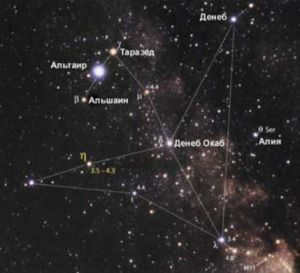
Significance in Asian Legends
There exists a tale in Japan concerning a youthful shepherd named Hikoboshi, who became infatuated with the celestial weaver Orihime (also known as Tanabata).
Each day, Orihime diligently wove the fabric of the heavens, but upon meeting Hikoboshi, she fell deeply in love with him and forgot her responsibilities. This angered the Goddess of Heaven (or, in some versions, the girl’s parents), who separated the lovers with the Heavenly River (the Milky Way), forever forbidding them from seeing one another.
However, due to numerous pleas and heartfelt cries from Orihime and Hikoboshi, the Goddess finally took pity and granted Hikoboshi permission to cross the river once per annum, specifically on the seventh day of the seventh month, allowing them to reunite, even if only for a brief period.
Up in the heavens, one can observe two luminous yet distantly positioned stars – Altair (Hikoboshi) and Vega (Orihime) – separated by the majestic Milky Way.
Japan commemorates this day as Tanabata, otherwise known as the Festival of Stars. It is widely believed that if rainfall occurs on this particular day, it symbolizes Orihime’s sorrowful tears, as Hikoboshi was unable to navigate the treacherous celestial river, ultimately resulting in the lovers’ inability to meet for yet another year.
The Japanese firmly hold the belief that Altair represents the star of ardent lovers, perpetually prepared to surmount the most treacherous obstacles, day in and day out.
Characteristics of the star
Altair lies a mere 16.8 light-years (5.14 parsecs – 159 trillion kilometers) away from our planet. It stands out as one of the nearest stars that can be seen without the aid of a telescope, and it holds the distinction of being the closest star of spectral class A, second only to Sirius.
Located in the constellation of Aquila.

Altair is a star in the constellation Aquila. It belongs to the spectral class A7 V and is located on the main sequence. Altair has a mass of approximately 1.8 solar masses and a luminosity of 11 times that of the Sun. Unlike the Sun, Altair rotates rapidly, completing a full revolution on its axis in just 8.9 hours. Its equatorial velocity is 286 km/s, much higher than the Sun’s equatorial speed of 2 km/s. Due to this fast rotation, Altair has a slightly larger diameter at the equator, about 22% larger than at the poles.
Satellite observations conducted in 1999 using the Wide Field Infrared Explorer indicated that Altair’s luminosity exhibits minor fluctuations within a range of less than one thousandth of a stellar magnitude. Consequently, in 2005, Altair was classified as a δ Shield type variable. The oscillation pattern of its brightness can be approximated by the superposition of multiple sine waves with periods spanning from 0.8 to 1.5 hours.
Altair, a celestial body possessing the characteristics of Mars and Jupiter, imparts qualities such as bravery, confidence, determination, ambition, and temporary yet substantial wealth. Individuals in whose astrological chart this particular white dwarf is present may find themselves involved in acts of violence.
When combined with the positive influence of other celestial bodies, Altair bestows endurance, courage, and integrity. Its presence in one’s horoscope is especially beneficial for those in the legal and military professions.
On January 22, 2009, the Sun aligned with Altair, the primary star of the Eagle constellation.
Altair is an exceptionally powerful and significant star in the night sky, ranking among the 20 brightest stars.
According to the Bible, the Magi gifted one of their horses to the baby Jesus and named it after the star Altair. This particular star has a strong influence on individuals born between January 21 and 22, April 21 and 22, July 24 and 25, October 24 and 25, September 24 and 25, and May 22 and 23. Additionally, those who have important planets, luminaries, or angles in their personal horoscope at the 2nd degree of Aquarius (as well as the entire Fixed Cross) are also affected by Altair’s energy.
Altair star in the birth chart
Influence: Opinions vary on this matter.
Ptolemy mentions the influence of Mars and Jupiter, Wilson emphasizes Saturn and Mercury, Simonite suggests Uranus, and Al-Widas points to the sextile aspect of Uranus and Mercury with the Sun. This individual is courageous, confident, and resolute. They may possess ambition and be free from prejudice, but they are also likely to experience fleeting wealth. They tend to sow discord. Negative effects include misfortune, dishonor, and potential ruin. Altair bestows an unwavering, reliable, enthusiastic, sharp, ambitious, and freedom-loving nature. It brings unexpected wealth that doesn’t last long. If the person holds a high social position, they may be accused of cruelty. They also face risks involving amphibians.
As per European tradition, Altair is believed to possess the qualities of Mars and Jupiter and is considered a fortunate star. However, Kefer suggests that Altair can bring about risky advancements and its influence is generally problematic, although its conjunction with the ASC is seen as highly favorable.
Devore, on the other hand, adds to the traditional interpretation by associating Altair with the characteristics of Uranus, Mercury, and the Sun. He believes that this star signifies bravery, self-assurance, stubbornness, generosity, and courage, as well as unexpected and illusory wealth, a position of leadership, and potential danger from reptiles.
F.Velichko observes that Altair, when positioned on the ASC, grants temporary fame and wealth. However, true stability and longevity can only be achieved through alignment with the Sun. This alignment can result in sustained fame, even if it occasionally involves scandalous incidents.
Rigor emphasizes that individuals with a prominent Altair in their horoscope tend to be bold, confident, and courageous. They may possess ambition and be free from prejudice, with the potential for significant but short-lived wealth. These individuals have a tendency to sow discord. In a negative scenario, they may experience misfortune, dishonor, and potential ruin.
According to P.Globe, Altair is supported by Uranus, Sun, Mars, and Jupiter, and bestows a heightened ability for visionary thinking, courage, determination, and entrepreneurial spirit. Altair is associated with a brilliant career, foresight, and a life filled with unexpected adventures and travel. It brings happiness on the journey and transforms individuals into fearless warriors.
As per Globa, Altair is linked to prophecies, leading the way into the future, the supernatural, sorcery, and frequently appears in individuals with a vast vision. Positioned on the edge of the VIII house, A. signifies airborne fatalities and falling from tall structures. In the medical astrology chart, it is a beneficial star, enhancing the respiratory system, nervous system, and providing healing from infections.
In D. Kutalev’s theory of star system interpretation, Altair, as the alpha of the constellation, corresponds to the Fire element at its most basic level of expression. As an A-class star, it is also linked to the Moon. According to this theory, Altair symbolizes a vibrant and self-assured nature, capable of showcasing one’s abilities and accomplishments, particularly in the material realm. This individual’s determination can sometimes border on cruelty. Altair’s influence is direct and unequivocal. The multiple aspects of Altair suggest challenges that may arise along one’s path, with changing goals potentially hindering the extent of one’s achievements. Health issues may also be a concern.
The inclusion of Altair, a prominent star, in your astrological chart imbues you with bravery and resolve. You possess the capacity to achieve success by taking risks and displaying assertiveness. However, Altair, being a star of action and might, utilizes these qualities not only for personal gain but also for the betterment of others.
Altair is considered a heliacal rising star at the time of your birth.
The alignment of Altair with the planets
In conjunction with the Sun: Progress in astrology, literary endeavors, and public affairs. This individual may experience unique and unforeseen events that can either benefit or harm them. They may form new and influential connections, some of whom may harbor envy and create challenges. They can expect honors, fame, and preferential treatment, but also face health issues, material losses, and danger from venomous creatures.
For those under the patronage of Altair, the Sun’s alignment signifies fame, the support of superiors, a large circle of friends, and a small group of detractors. However, it also indicates potential health problems and unexpected losses. Additionally, they should exercise caution to avoid bites from venomous reptiles.
When the Moon is in conjunction: This alignment can bring about unique and extraordinary experiences for an individual, sparking their curiosity in unusual findings, some of which may be peculiar or deeply rooted in history. It is possible for the person to encounter disappointments and losses of various kinds. However, the person possesses a remarkable talent for overcoming obstacles and defeating their adversaries. Additionally, they have the potential to develop exceptional writing skills and may achieve everlasting fame. There is a strong indication of possessing great intellectual abilities. The alignment also suggests the potential for encountering troubles related to public affairs. Furthermore, the person may face difficulties caused by their friends, some of whom are content with a mundane everyday life but have the potential to emerge as influential leaders. Overall, this alignment signifies an affinity for uncommon or ancient discoveries, possible disappointments, financial setbacks, average earnings and social status, friends turning into foes, troubles in personal and professional matters, and challenges related to children or their misfortunes.
Altair, together with the moon, brings good fortune to those who have an interest in curious and ancient findings. When influenced by Altair, one may experience setbacks, loss of assets, missed opportunities for profit, minor gains, conflicts with friends, and issues related to national affairs. Children may face challenges and misfortunes.
When combined with Mercury: The individual has the potential to overcome obstacles, but it remains uncertain whether they will be able to harness this ability. Unusual experiences await them, including prophetic dreams, extraordinary journeys, and surprising discoveries. They may also encounter domestic problems and disappointments during a long trip, unsatisfactory partnerships, and the loss of family members under mysterious circumstances.
When Altair is in conjunction with the planet Mercury, it signifies numerous challenges, failures, and questionable encounters. One may be disappointed during a long journey and experience the loss of a loved one in peculiar circumstances.
When Venus is prominent: The individual may find themselves entangled in contentious matters. Some of these individuals may have unconventional attachments. Their friends may cause unnecessary troubles. A person with an unfavorable horoscope may create problems for themselves, leading to unhappiness and even violence. Unrequited love may be experienced. They possess a strong and peculiar charm. This placement is not favorable for children and financial gains, as losses may occur due to friendships. Love affairs may end in failure, characterized by unexpected and unusual charm. Losses may also occur due to friendships.
When Mars is prominent: This person is perceptive, however, they may encounter difficulties related to their acquaintances or professional activities. They possess wit, but may face troubles with friends, business contacts, and their own ill-conceived endeavors. Despite these challenges, the individual ultimately remains in a favorable position. Problems related to their environment may arise, but will ultimately be resolved safely.
When Saturn is present: there may be feelings of sorrow and disappointment, as well as potential damage to the mind which could result in the individual being placed in a hospital or mental institution, where they unfortunately often pass away. This placement could also lead to separation from family and relatives, as well as misfortune that may leave the person either incapacitated or bitter for the remainder of their life. Additionally, there is a possibility of experiencing grief and disappointment, as well as developing mental disorders that require medication. There is also a likelihood of death due to these mental disorders, and a potential for separation from family and parents. Lastly, there is a danger of accidents followed by disabilities.
When Neptune is present: there may be a heightened sensitivity, as well as the potential for mystical events and the presence of secret enemies. This placement may also lead to a lack of harmony in the home and the possibility of sudden death.
When it comes to Uranus: there is a presence of fearfulness, spirituality, sensitivity, compassion, and at times, irascibility. There is also a strong sense of justice and idealism, as well as an interest in occultism while being skeptical of traditional religion. Early childhood impressions hold significant importance, and throughout life, there is a sense of being haunted by disappointments. Despite this, there is a strong mind and the potential for solid profits. Those with Uranus in their chart tend to have loyal and educated friends of the Gemini type, but may also experience some degree of torment among relatives. Ultimately, their life tends to come to a natural end in deep old age.
Observation Aftermath
Altair, an astonishing star that continues to captivate astronomers to this very day.
One of its most intriguing astronomical characteristics is its heterogeneity, although it remains imperceptible to the naked eye. However, in 2004, scientists managed to capture the necessary images with the aid of specialized equipment, revealing striking differences in brightness across different regions of the celestial body. This phenomenon still perplexes astronomers, lacking any plausible explanation.
Aside from its remarkable luminosity, Altair also stands out as one of the swiftest among its counterparts.
In 2007, the CHARA interferometer made history by capturing the first-ever surface images of Altair.
Astrometeorology
When the sun rises in the evening, it indicates the presence of hurricanes. However, when the sun rises with the sun, it suggests the occurrence of snow. On the other hand, if the sun is setting in the morning, it is a sign of intense heat and southeasterly winds. When Mercury is present, it is likely to snow with rain. Moreover, the presence of Mars usually brings rain, snow, and severe cold. If the sun is rising or setting, expect turbulent, windy, and stuffy weather. When Jupiter and Mars are both present, it is likely to experience wind, hail, summer thunderstorms, and warm winters, especially if Jupiter is stationary. (A.Aich)
Altair, along with Vega and Deneb, forms a part of the Summer Triangle, a prominent asterism in the northern hemisphere. Altair is specifically located in the constellation Eagle, while Vega is found in the constellation Lyra and Deneb in the constellation Swan.

Among the three stars, Vega shines the brightest. Altair takes second place. Deneb appears comparatively faint next to its counterparts. It is three times less bright than Vega, however, it is one of the largest supergiant stars currently known. The star in the constellation Swan is 80,000 times more luminous than the Sun, but due to its distance of 1,467 light-years from Earth, it appears completely devoid of luminosity.
Physical characteristics
Altair is a fixed star that serves as the alpha of the Eagle constellation. It has an apparent stellar magnitude of 0.77m and belongs to the spectral class A7 V. Altair is actually a triple star system, with the two main components 0.8m and 9.5m being 152.4″ apart in terms of angular distance. The main component, Atair, has a radius that is 1.4 times that of the Sun.
Altair’s luminosity is equivalent to 10 times that of the Sun, and it is located at a distance of 5.1 parsecs from our Solar System. In terms of astronomical position, at epoch 2000.0, Altair’s right ascension is 19h50m47.0s, its declination is +08°52’06”, its longitude is 301°46’35”, and its latitude is +29°18’13”. Among the stars in the Eagle constellation, Altair shines the brightest and is the 12th brightest star in the entire sky. Its visible luster has a magnitude of 0.77m. The name Altair is derived from the Arabic phrase “an-nasr at-tair” (Arabic النسر الطائر), which means “soaring eagle”.
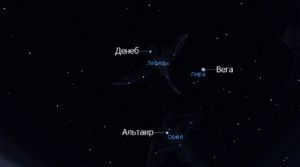
Altair, situated in the Northern Hemisphere, is a prominent star that can be observed during the summer and fall seasons. It is part of the renowned “summer-fall triangle” and forms a constellation line along with Beta and Gamma Eagle, which is often referred to as the Eagle Family or the Eagle Shaft.
Compression and surface temperature
The measurement of Altair’s angular size was conducted using interferometry by Robert Brown and his team during the 1960s. Their findings revealed that its diameter measures 3 angular milliseconds. Additionally, they proposed a hypothesis that Altair had a significant flattening effect caused by its rapid rotational velocity. However, their equipment at the time was not sensitive enough to observe this phenomenon.
Furthermore, a study conducted by Dominicano de Souza (2005) examined the phenomenon of gravitational darkening by analyzing data collected with the VINCI instrument at VLTI. Altair stands out among other stars due to the availability of direct images capturing its disks. This allowed researchers to directly observe both the gravitational darkening effect and the resulting flattening effect.
The significance of Altair in today’s society
In the modern world, Altair holds various meanings and associations. In the 1956 American movie Forbidden Planet, Altair is depicted as a massive galaxy called Altair 4, serving as the primary setting for the film’s events.
Altair ibn La’Ahad is a prominent character in the popular Assassin’s Creed series of video games. The choice of the name Altair for this character is fitting, as the game’s storyline incorporates references to eagles.
Furthermore, in 2007, NASA decided to pay tribute to Altair by naming their lunar module after this celestial star. While the lunar module is currently just a concept, the US government plans to develop a functional model and carry out a moon landing mission by 2018.
Did you know these interesting facts about the star Altair?
Altair not only emits X-ray radiation, but it is also a key component of a well-known asterism known as the Autumn-Summer Triangle. This celestial formation consists of the stars Alpha Eagle, Alpha Lyra, and Alpha Swan.
Recommended literature for further reading:
1. Atlas of the Starry Sky
2. Saplin A. Astrological Encyclopedic Dictionary
3. Ptolemy K. Tetrabiblos
4. Ptolemy C. Almagestus
5. Insalita A. Astronomy for Astrologers
6. Globa P. Fixed Stars
7. Ebertin R., Hofmann G. Fixed Stars and Their Interpretation
8. Kefer J. Practical Astrology
9. Filippova M. Medical Astrology
10. Rigor J. Astrological Influence of Fixed Stars
11. Kutalev D. General Theory of Star Interpretation
12. deVore N. Encyclopedia of Astrology
13. The International Encyclopedia of Astronomy / Ed. by P.Moore.


